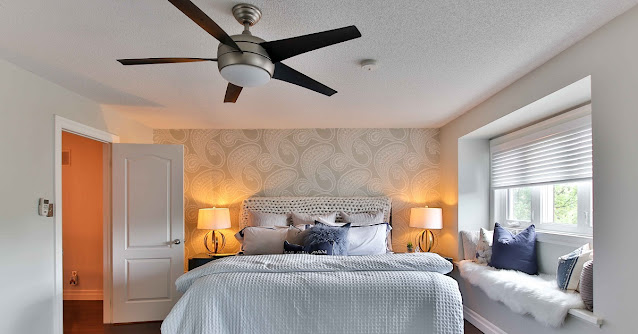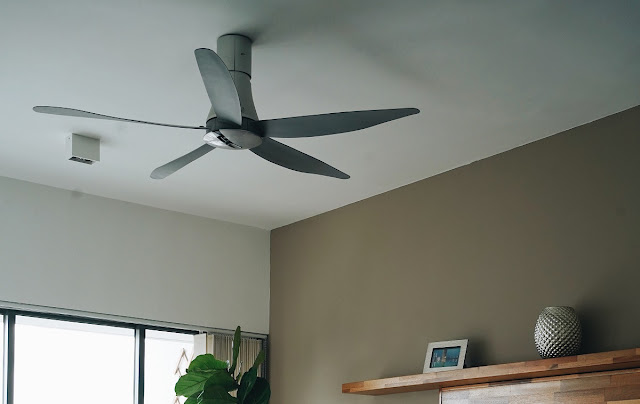You already know that ceiling fans are a must for keeping your home comfortable. But they have a few secrets too. When you know their secrets, you can make the most of your ceiling fans. From increasing your heating and cooling efficiency to getting maximum air circulation, here are seven things you may not know about your ceiling fans.
#1 Ceiling Fans Can Increase Heating/Cooling Efficiency
Ceiling fans do more than provide a little airflow on a hot day. Did you know that you can change the direction your fan turns? When it turns clockwise, it pushes air down. When it turns counterclockwise, it draws air up. Why is this important? Hot air rises so depending on which season it is, you’ll want the hot air to be directed differently.
Setting your ceiling fan for summer vs winter is a matter of logic. When that hot air rises in the summer, you’ll want to push it down to blend it with cooler air and maintain a more consistently cool temperature. In the winter, you don’t want all that hot air at the ceiling; you want it down by your cold toes. Set your ceiling fan direction for summer vs winter like this:
Summer = Counterclockwise
Winter = Clockwise
#2 Ceiling Fans Can Be Virtually Silent
Have you ever laid awake at night and instead of counting sheep you listen to the hum of the fan above your bed? Did you know there are whisper quiet ceiling fans? They can be practically undetectable (although the airflow is a dead giveaway).
Quiet ceiling fans are all about technology. Look for a fan with an oil bath motor. These are pretty heavy and require an oil check every 1-5 years. However, they are top notch ceiling fans. Another option is a flywheel motor. It is an AC motor with flywheel discs that absorb shock and that means a quieter ceiling fan. On the flip side, a DC motor has a higher torque and better control. They are lightweight and very quiet.
#3 The Number of Fan Blades Is Not Just About Style
Did you know that the number of blades your ceiling fan has is mostly about performance? Ceiling fans generally come in 3, 4, or 5 blades, though occasionally you’ll see fans with more or less. If you want a gentle breeze, look for more blades. If you want more of a wind chill effect, look for fewer blades.
The fewer the blades, the less drag there is. The less drag, the faster the blades can spin creating more airflow. Ceiling fans with 2 or 3 blades really move the air around and make their presence known. Fans with 4 or 5 (or more) blades have a gentler airflow. They also tend to be quieter.
#4 The Pitch of the Blades Has a Huge Impact on Performance
The fan blades determine how much air gets circulated through the room. Did you know that the angle (or pitch) that the blades sit at and the shape of the blades can change airflow dramatically? Fan blades between 12-15 degrees will move the most air. Anything less than that won’t be enough and more than that will be too much.
Balance is the bottom line when it comes to ceiling fans. If the angles of each blade don’t match, the fan will wobble, which can cause inefficiency and even damage. Fan blades also have to weigh exactly the same or you’ll get a wobble. Ceiling fans must be precise. If they’re not, they’ll be noisy and completely dysfunctional.
#5 Shape & Size of the Blade Can Impact Your Electric Bill
Did you know that the shape and size of the blades significantly change how much air circulates and therefore can influence how much electricity it takes to create airflow in your room? Blades that are extra long or wide, ironically, move less air than a moderately sized blade if the motor doesn't have the right level of power. Same goes for narrower and shorter blades. The motor needs to match the size of the blade.
Most fan blades are a sort of rectangular shape with tapered or rounded ends. You’ll also see some alternative shapes that tout higher energy efficiency and better air circulation. These often look like plane propeller blades. Do they work better? Maybe. But for the purposes of your home, standard blades get the job done just as well.
#6 Different Ceiling Heights Require Different Installation
Depending on the height of your ceiling, you may have to install your ceiling fan differently. Did you know that airflow is impacted by the distance between the fan and the floor/ceiling? There are two rules of thumb when it comes to how to hang your ceiling fan. A fan that is 10-12 inches from the ceiling does the best job with air circulation. However, if the ceilings aren’t standard height, everything changes.
The better rule to go by states that a ceiling fan should be 8-9 feet from the floor. If you have vaulted ceilings or extra tall ceilings, your fan will work best when hung from a downrod. If you have lower ceilings, you may need to consider a fan designed to be closer to the ceiling, called a flush mount, low profile, or hugger fan.
#7 A Bigger Room Doesn’t Always Need a Bigger Fan
You might think that a bigger room needs a bigger fan and that’s usually true. Did you know that the shape of the room is the determining factor for the size of the fan? In general, you can only feel the airflow of a ceiling fan if you stand no more than two feet outside its radius. Mathematically, a ceiling fan works best in a square room. If you have a square room you can scale the fan up in size the larger the room gets.
8 x 8 foot room needs a 30 inch diameter fan or smaller
9 x 9 foot room needs a 41 to 50 inch diameter fan
12 x 12 foot room needs a 51 to 60 inch diameter fan
16 x 16 or larger foot room needs a 61 to 70 inch diameter fan
If your room is rectangular, a bigger fan’s effectiveness will be limited. In long rooms, it’s often better to use multiple fans spread equally across the room. Split the room’s measurements into two equal squares then buy the right diameter fan for each of the squares.
Whether you wonder about the ceiling fan direction in the winter vs the summer or you’re not sure about which ceiling fans move the most air, we hope these ceiling fan facts help make your decisions easier.








